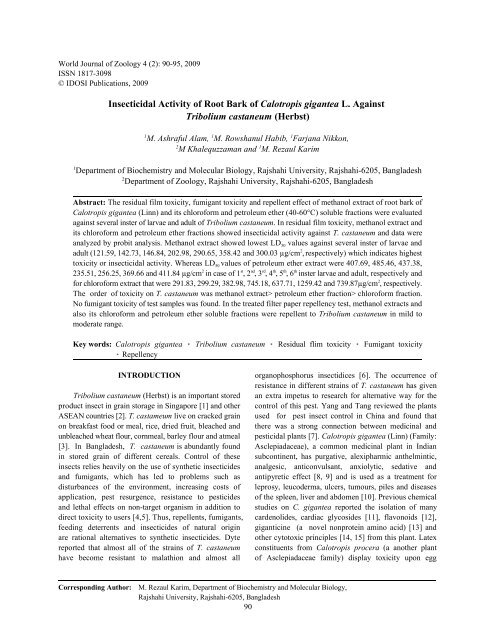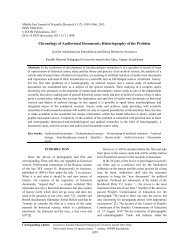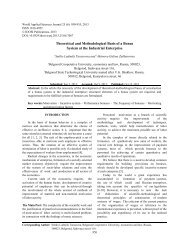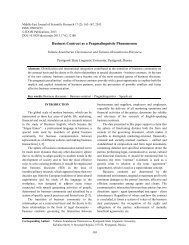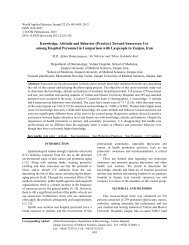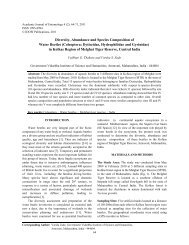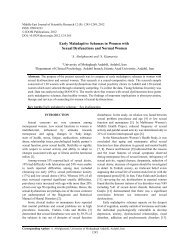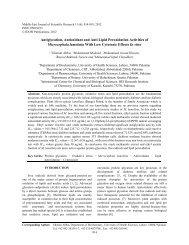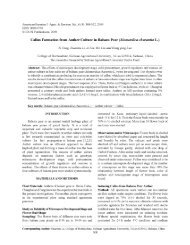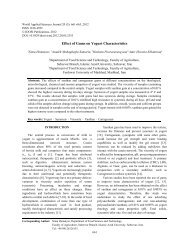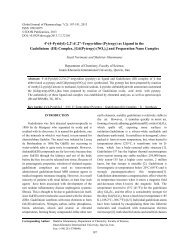Insecticidal Activity of Root Bark of Calotropis gigantea L ... - Idosi.org
Insecticidal Activity of Root Bark of Calotropis gigantea L ... - Idosi.org
Insecticidal Activity of Root Bark of Calotropis gigantea L ... - Idosi.org
You also want an ePaper? Increase the reach of your titles
YUMPU automatically turns print PDFs into web optimized ePapers that Google loves.
World Journal <strong>of</strong> Zoology 4 (2): 90-95, 2009<br />
ISSN 1817-3098<br />
© IDOSI Publications, 2009<br />
<strong>Insecticidal</strong> <strong>Activity</strong> <strong>of</strong> <strong>Root</strong> <strong>Bark</strong> <strong>of</strong> <strong>Calotropis</strong> <strong>gigantea</strong> L. Against<br />
Tribolium castaneum (Herbst)<br />
1 1 1<br />
M. Ashraful Alam, M. Rowshanul Habib, Farjana Nikkon,<br />
2 1<br />
M Khalequzzaman and M. Rezaul Karim<br />
1Department<br />
<strong>of</strong> Biochemistry and Molecular Biology, Rajshahi University, Rajshahi-6205, Bangladesh<br />
2Department<br />
<strong>of</strong> Zoology, Rajshahi University, Rajshahi-6205, Bangladesh<br />
Abstract: The residual film toxicity, fumigant toxicity and repellent effect <strong>of</strong> methanol extract <strong>of</strong> root bark <strong>of</strong><br />
<strong>Calotropis</strong> <strong>gigantea</strong> (Linn) and its chlor<strong>of</strong>orm and petroleum ether (40-60°C) soluble fractions were evaluated<br />
against several inster <strong>of</strong> larvae and adult <strong>of</strong> Tribolium castaneum. In residual film toxicity, methanol extract and<br />
its chlor<strong>of</strong>orm and petroleum ether fractions showed insecticidal activity against T. castaneum and data were<br />
analyzed by probit analysis. Methanol extract showed lowest LD 50 values against several inster <strong>of</strong> larvae and<br />
2<br />
adult (121.59, 142.73, 146.84, 202.98, 290.65, 358.42 and 300.03 µg/cm , respectively) which indicates highest<br />
toxicity or insecticidal activity. Whereas LD50 values <strong>of</strong> petroleum ether extract were 407.69, 485.46, 437.38,<br />
2 st nd rd th th th<br />
235.51, 256.25, 369.66 and 411.84 µg/cm in case <strong>of</strong> 1 , 2 , 3 , 4 , 5 , 6 inster larvae and adult, respectively and<br />
2<br />
for chlor<strong>of</strong>orm extract that were 291.83, 299.29, 382.98, 745.18, 637.71, 1259.42 and 739.87µg/cm , respectively.<br />
The order <strong>of</strong> toxicity on T. castaneum was methanol extract> petroleum ether fraction> chlor<strong>of</strong>orm fraction.<br />
No fumigant toxicity <strong>of</strong> test samples was found. In the treated filter paper repellency test, methanol extracts and<br />
also its chlor<strong>of</strong>orm and petroleum ether soluble fractions were repellent to Tribolium castaneum in mild to<br />
moderate range.<br />
Key words: <strong>Calotropis</strong> <strong>gigantea</strong> Tribolium castaneum Residual flim toxicity Fumigant toxicity<br />
Repellency<br />
INTRODUCTION <strong>org</strong>anophosphorus insectidices [6]. The occurrence <strong>of</strong><br />
resistance in different strains <strong>of</strong> T. castaneum has given<br />
Tribolium castaneum (Herbst) is an important stored an extra impetus to research for alternative way for the<br />
product insect in grain storage in Singapore [1] and other control <strong>of</strong> this pest. Yang and Tang reviewed the plants<br />
ASEAN countries [2]. T. castameum live on cracked grain used for pest insect control in China and found that<br />
on breakfast food or meal, rice, dried fruit, bleached and there was a strong connection between medicinal and<br />
unbleached wheat flour, cornmeal, barley flour and atmeal pesticidal plants [7]. <strong>Calotropis</strong> <strong>gigantea</strong> (Linn) (Family:<br />
[3]. In Bangladesh, T. castaneum is abundantly found Asclepiadaceae), a common medicinal plant in Indian<br />
in stored grain <strong>of</strong> different cereals. Control <strong>of</strong> these subcontinent, has purgative, alexipharmic anthelmintic,<br />
insects relies heavily on the use <strong>of</strong> synthetic insecticides analgesic, anticonvulsant, anxiolytic, sedative and<br />
and fumigants, which has led to problems such as antipyretic effect [8, 9] and is used as a treatment for<br />
disturbances <strong>of</strong> the environment, increasing costs <strong>of</strong> leprosy, leucoderma, ulcers, tumours, piles and diseases<br />
application, pest resurgence, resistance to pesticides <strong>of</strong> the spleen, liver and abdomen [10]. Previous chemical<br />
and lethal effects on non-target <strong>org</strong>anism in addition to studies on C. <strong>gigantea</strong> reported the isolation <strong>of</strong> many<br />
direct toxicity to users [4,5]. Thus, repellents, fumigants, cardenolides, cardiac glycosides [11], flavonoids [12],<br />
feeding deterrents and insecticides <strong>of</strong> natural origin giganticine (a novel nonprotein amino acid) [13] and<br />
are rational alternatives to synthetic insecticides. Dyte other cytotoxic principles [14, 15] from this plant. Latex<br />
reported that almost all <strong>of</strong> the strains <strong>of</strong> T. castaneum constituents from <strong>Calotropis</strong> procera (a another plant<br />
have become resistant to malathion and almost all <strong>of</strong> Asclepiadaceae family) display toxicity upon egg<br />
Corresponding Author: M. Rezaul Karim, Department <strong>of</strong> Biochemistry and Molecular Biology,<br />
Rajshahi University, Rajshahi-6205, Bangladesh<br />
90
World J. Zool., 4 (2): 90-95, 2009<br />
hatching and larvae <strong>of</strong> Aedes aegypti (Linn.) [16]. Singh 5 ml <strong>of</strong> corresponding solvent to get concentrations <strong>of</strong><br />
et al. reported the larvicidal properties <strong>of</strong> leaf extract <strong>of</strong> 40 mg/ml, 20 mg/ml, 10 mg/ml and 5 mg/ml respectively<br />
<strong>Calotropis</strong> procera against mosquito larvae <strong>of</strong> Anopheles which were used as stock solutions. 1 ml <strong>of</strong> various<br />
stephensi, Culex quinquefasciatus and Aedes aegypti concentrations for each sample was applied on<br />
[17]. Despite the previous studies on bioactivity <strong>of</strong> root petridishes (7 cm diameter) in such a way that it made a<br />
bark <strong>of</strong> C. <strong>gigantea</strong> to various research, its activity uniform film over the petridishes. For solvent evaporation,<br />
against T. castaneum (Herbst) has not yet been the petridishes were air dried leaving the extract on it. The<br />
determined. The present research was therefore under actual extract present in 1ml mixture was calculated and<br />
taken to investigate the effect <strong>of</strong> the methanol extract <strong>of</strong> the dose per square centimeter was determined by<br />
root bark <strong>of</strong> <strong>Calotropis</strong> <strong>gigantea</strong> and its chlor<strong>of</strong>orm and dividing the value present in one ml with the area <strong>of</strong><br />
petroleum ether soluble fractions against adults and<br />
2<br />
the petridish. So calculated doses were 1040.5 µg/cm ,<br />
several inster <strong>of</strong> larvae <strong>of</strong> T. castaneum (Herbst).<br />
2 2 2<br />
520.0 µg/cm , 260.0 µg/cm and 130.0 µg/cm . After drying<br />
10 beetles were released in each petridish with three<br />
MATERIALS AND METHODS replication. A control batch was also maintained with the<br />
same number <strong>of</strong> insects after preparing the petridish by<br />
Insects: Adults <strong>of</strong> T. castaneum were collected from the applying and evaporating the solvent only. The treated<br />
Crop Protection Lab <strong>of</strong> the Department <strong>of</strong> Agriculture and beetles were placed in an incubator at the same<br />
Environmental Science, University <strong>of</strong> Newcastle upon temperature as reared in stock cultures and the<br />
Tyne, UK and successfully reared for more than ten years mortality <strong>of</strong> the beetles were counted after 24 hour<br />
in the Crop Protection and Toxicology Lab <strong>of</strong> the Institute<br />
<strong>of</strong> Biological Science, Rajshahi University. Mass cultures<br />
post-exposure [24].<br />
were maintained in Jars (1000 ml) containing food Fumigant Toxicity: Each filter paper (diameter 2.0 cm)<br />
medium and kept in an incubator at 30±1°C and 70-80% were impregnated with 0.2 ml <strong>of</strong> various concentrations<br />
(Relative Humidity). A stand ard mixture <strong>of</strong> sterilized (20 mg/ml, 10 mg/ml and 5 mg/ml) <strong>of</strong> each extract and<br />
(at 60°C for 24 hours) whole-wheat flour with powdered fractions and placed on the underside <strong>of</strong> the screw cap <strong>of</strong><br />
dry yeast in a ratio <strong>of</strong> 19:1 was used as food medium in the a glass vial (diameter 2.5cm, height 5.5 cm). Then<br />
experiments [18-20].<br />
2 2<br />
calculated doses were 884.20 µg/cm , 442.10 µg/cm and<br />
2<br />
221.05 µg/cm . The solvent was allowed to evaporate for<br />
Extraction: The plant C. <strong>gigantea</strong> L. was taxonomically 1 min. before the cap was screwed tightly on the glass vial<br />
identified by Pr<strong>of</strong>essor A.T.M Naderuzzaman, Department containing 10 insects. Respective solvent was used as<br />
<strong>of</strong> Botany, University <strong>of</strong> Rajshahi. Voucher specimen control. Six replicates were prepared for each treatment<br />
(No. 1A. Alam, collection date 15.08.2004) was kept in the and control. Mortality counts were made after 24 hours <strong>of</strong><br />
Dept. <strong>of</strong> Botany, University <strong>of</strong> Rajshahi. <strong>Root</strong> bark <strong>of</strong><br />
C. <strong>gigantea</strong> were collected, dried and ground to powder.<br />
treatment.<br />
It was then extracted with methanol in Soxhlets apparatus, Repellency Test: The repellency test used was adopted<br />
the process described by Schmutterer [21]. The extract from the method McDonald [25] with some modifications<br />
was then filtered through Whatman No.1 filter paper. The by Talukder and Howse [26, 27]. Half filter paper discs<br />
filtrate was concentrated with a rotary evaporator under (Whatman No. 40, diameter 9 cm) were prepared with<br />
reduced pressure at 50° C to afford crude methanol extract 0.1 ml <strong>of</strong> various concentrations <strong>of</strong> each testing samples<br />
(40 gm). This crude methanol extract (30 gm) was then (methanol extract and its chlor<strong>of</strong>orm and petroleum ether<br />
fractionated into petroleum ether (3 g) and chlor<strong>of</strong>orm soluble fractions) and allowed to air-dry for 10 minutes.<br />
(10 g) by solvent-solvent partitioning [22]. Each treated half disc was then attached lengthwise,<br />
edge-to-edge, to a control half-disc with adhesive tape<br />
Residual Film Method <strong>of</strong> Toxicity: Residual film and placed in a petridish (dimeter 9 cm), the inner surface<br />
method as described by Busvine, was used [23]. A <strong>of</strong> which was smeared with flour to prevent insects<br />
preliminary screening <strong>of</strong> different doses was performed escaping. The orientation <strong>of</strong> the seam was changed in the<br />
on several insters <strong>of</strong> larvae and adults to obtain 0% to replicates to avoid the effects on any external directional<br />
100% mortalities. Then 200 mg, 100 mg, 50 mg and 25 mg stimulus <strong>of</strong>fering the distribution <strong>of</strong> the test insects.<br />
<strong>of</strong> each test sample (Methanol extract, chlor<strong>of</strong>orm fraction Twenty adults insects were released in the middle <strong>of</strong> each<br />
and petroleum ether fraction) were dissolved separately in filter-paper circle and a plastic cover with some small<br />
91
World J. Zool., 4 (2): 90-95, 2009<br />
holes was placed on the petri dish [29]. Each<br />
concentration was tested five times. Insects that settled<br />
RESULTS<br />
on each half <strong>of</strong> the filter paper disc were counted after 1h Residual Film Toxicity: Residual film toxicity showed that<br />
and then at hourly intervals for 5 hours. No significant methanol extract and its chlor<strong>of</strong>orm and petroleum ether<br />
difference as detected between the repellency <strong>of</strong> solvent soluble fractions <strong>of</strong> root bark <strong>of</strong> C. <strong>gigantea</strong> were found<br />
impregnated (methanol, chlor<strong>of</strong>orm and petroleum ether) to be toxic to T. castaneum (Table 1). On the basis <strong>of</strong> LD50<br />
and untreated filter papers in tests designed to check for and LD 90 value, it was observed that among the tested<br />
any possible influence <strong>of</strong> solvents. The average <strong>of</strong> the materials methanol extract showed highest toxicity.<br />
counts was converted to percentage repellency (PR) However according to the intensity <strong>of</strong> toxicity they could<br />
using the formula <strong>of</strong> Talukder and Howse [26, 27] be arranged in the following order methanol extract><br />
petroleum ether extract> chlorform extract. It was also<br />
PR= 2(C-50)<br />
Where C is the percentage <strong>of</strong> insects on the<br />
observed that younger larvae were more susceptible than<br />
older larvae and adults.<br />
untreated half <strong>of</strong> the disc. Positive values expressed Repellency: Methanol extract <strong>of</strong> C. <strong>gigantea</strong> and its<br />
repellency and negative values attractancy. The data chlor<strong>of</strong>orm and petroleum ether fraction showed repellent<br />
were analyzed for percents repellency (PR) and were toxicity in mild to moderate range (Table 2). Repellency<br />
transformed them into arcsine percentage values. increased with concentration and in case <strong>of</strong> methanol<br />
Table 1: Residual Film toxicity <strong>of</strong> root bark extracts <strong>of</strong> C. <strong>gigantea</strong> against T. castaneum larvae and adults<br />
Plant materials Life stage 2 LD 50 (µg/cm ) 95% Con. Limit 2<br />
LD 90 (µg/cm ) 95% Con. Limit Slope±SE<br />
Methanol st 1 Inster 121.59 86.30-171.32 316.22 273.71-358.73 3.035+0.04<br />
extract nd 2 Inster 129.44 107.02-190.35 363.07 321.41-404.75 3.13+0.02<br />
rd 3 Inster 146.84 108.87-198.05 405.51 360.92-450.09 2.87+0.03<br />
th 4 Inster 235.65 154.61-266.48 645.65 589.72-701.58 2.53+0.001<br />
th 5 Inster 290.65 185.68-454.96 3090.29 2955.66-3224.92 1.24+0.002<br />
th 6 Inster 358.42 262.31-489.73 1905.46 1791.76-2019.16 1.77+0.005<br />
Adult 326.1 210.50-427.63 1905.46 1796.90-2014.02 1.625+0.04<br />
Chlor<strong>of</strong>orm st 1 Inster 253.05 208.34-408.78 1018.59 918.37-1118.81 2.39+0.02<br />
fraction nd 2 Inster 299.29 206.28-434.23 1230.27 1116.29-1344.24 2.43+0.34<br />
rd 3 Inster 382.98 257.65-569.26 2290.86 2135.06-2446.67 1.65+0.02<br />
th 4 Inster 745.18 585.39-948.58 2511.88 2330.29-2693.47 2.39+0.001<br />
th 5 Inster 541.62 452.68-898.37 3981.07 3758.23-4203.91 1.60+0.007<br />
th 6 Inster 605.87 758.88-2090.12 5397.61 10554.56-11885.80 1.375+0.03<br />
Petroleum ether Adult 739.87 529.11-1034.58 4365.15 4112.42-4617.88 1.66+0.02<br />
fraction st 1 Inster 407.69 302.38-549.67 1267.06 1143.42-1390.72 2.57+0.03<br />
nd 2 Inster 485.46 282.35-834.68 2818.38 2542.22-3094.55 1.69+0.04<br />
rd 3 Inster 437.38 346.40-552.26 1348.96 1246.04-1451.88 2.67+0.09<br />
th 4 Inster 235.51 171.22-323.93 1047.12 970.77-1123.47 1.96+0.003<br />
th 5 Inster 256.25 187.48-350.26 1174.89 1093.50-1256.28 1.91+0.0001<br />
th 6 Inster 369.66 283.02-482.83 1479.1 1379.20-1579.00 2.11+0.01<br />
Adult 411.84 287.42-590.11 2818.38 2667.04-2969.72 1.54+0.015<br />
Table 2: Repellency <strong>of</strong> T. castaneum adults by methanol extract <strong>of</strong> root bark <strong>of</strong> C. <strong>gigantea</strong> and its chlor<strong>of</strong>orm and petroleum ether fractions<br />
Repellency percentage (arsine) at intervals<br />
---------------------------------------------------------------------------------------------------------------------------------------------<br />
Plant material 2<br />
Dose µg/cm 1h 2h 3h 4h 5h<br />
Methanol 1260 -13.4 (-21.47) 00 (00) -20 (-26.56) 6.6 (14.89) 26.6 (31.05)<br />
extract 630 -26.6 (-31.05) -20 (-26.56) -13.4 (-21.47) 6.6 (14.89) 6.6 (14.89)<br />
315 -26.6 (-31.05) -40 (-39.23) -20 (-26.56) -26.6 (-31.05) -6.6 (-14.89)<br />
157 -26.6 (-31.05) -13.4 (-21.47) -26.6 (31.05) -26.6 (-31.05) 13.4 (21.47)<br />
Chlor<strong>of</strong>orm 1260 -13.4 (-21.47) -20 (-26.56) 00 (00) 20 (26.56) 33.4 (35.30)<br />
fraction 630 -6.6 (-14.89) -6.6 (-14.89) 6.6 (-14.89) -20 (-26.50) 13.4 (21.5)<br />
315 -33.4 (-35.30) -13.4 (-21.47) -6.6 (14.89) 00 (00) 00(00)<br />
157 -40 (-39.23) -26.6 (-31.05) 6.6 (14.89) 00 (00) 00(00)<br />
Petroleum 1260 46.6 (43.05) 26.6 (31.05) 13.40 (21.47) -13.4 (-21.47) -13.4 (-21.47)<br />
ether 630 20 (26.56) 00 (00) -13.4 (-21.47) -26.6 (-31.05) -20 (-26.56)<br />
fraction 315 26.6 (31.05) 00 (00) -13.4 (-21.47) -26.6 (-31.05) -20 (-26.56)<br />
157 6.6 (13.89) -6.6 (13.89) -6.6 (13.89) 00 (00) -26.6 (31.05)<br />
92
World J. Zool., 4 (2): 90-95, 2009<br />
extract and chlor<strong>of</strong>orm fraction repellent effect The repellent activity <strong>of</strong> petroleum ether fraction<br />
increased with time but in case <strong>of</strong> petroleum ether decreased with time, a trend similar to crude extracts<br />
fraction, the repellent effect decreased with time over <strong>of</strong> pithraj [26]. It is very likely that the repellent<br />
the 5 experimental period. constituent(s) <strong>of</strong> the petroleum ether fraction have low<br />
molecular weights and high volatility [30]. This property<br />
Fumigant Toxicity: The extracts demonstrated no <strong>of</strong> high volatility is further evident from the lack<br />
fumigant toxicity to T. castaneum. fumigation activity when treated filter papers were<br />
evaporated for 5 minutes or longer before being capped<br />
DISCUSSION on the glass vials in the preliminary experiments.<br />
This study demonstrates that the methanol extract <strong>of</strong><br />
The methanol extract <strong>of</strong> root bark <strong>of</strong> C. <strong>gigantea</strong> root bark <strong>of</strong> C. <strong>gigantea</strong> and its chlor<strong>of</strong>orm and petroleum<br />
and its chlor<strong>of</strong>orm and petroleum ether soluble fractions ether soluble fraction had residual film toxicity and<br />
were showed the insecticidal activity and repellent repellent toxicity against T. castaneum with different<br />
toxicity to adults and larvae <strong>of</strong> T. castanium. T. castaneum efficacies. These finding suggest that there may be<br />
larvae were more susceptible than adults. Methanol different constituents in the methanol extracts and its<br />
extract proved to be more toxic than other fractions in chlor<strong>of</strong>orm and petroleum ether fraction possessing<br />
all larval and adult stages. It is interesting to note that in different bioactivities but their identities are yet to be<br />
all extracts LD 50 values were more or less similar from determined. The isolation and identification <strong>of</strong> the<br />
st th th<br />
1 inster to 5 inster larvae but in the 6 inster larvae bioactive c ompound(s) in the extracts <strong>of</strong> root bark <strong>of</strong><br />
LD50 values were jumped indicating more tolerant. In C. <strong>gigantea</strong> are <strong>of</strong> out most importance so that their<br />
st<br />
case <strong>of</strong> methanol and chlor<strong>of</strong>orm fraction, 1 inster potential application in controlling stored-product pest<br />
larvae showed lowest LD 50 and LD90 values indicating can be fully exploited.<br />
more toxic to this larval stage. In case <strong>of</strong> petroleum<br />
th th<br />
ether fraction LD 50 values against the 4 and 5 inster<br />
larvae were dropped indicating the more toxic to these<br />
REFERENCES<br />
larval stages. This present result <strong>of</strong> mortality is similar 1. Pranoto, R.I., M.S. Sim, A.M.E. Howie and S.H. Ho,<br />
to the work <strong>of</strong> M. Khalequzzaman, who reported that 1991. Grain Storage Pand control practices in<br />
ethyl acetate extract <strong>of</strong> Neem (Azadirachta indica) Singapore. In Current Trends in Integrated Pest<br />
leaf showed lowest LD50 th<br />
value on 5 instar larvae Management For Grain Storage in the ASEAN<br />
indicating more susceptible to this larval stage [28]. Region, Eds., Frio, A.S., ASEAN Grain Postharvest<br />
Fumigation activity <strong>of</strong> the extracts were investigated Programme, Thailand, pp: 67-80.<br />
but no mortality were found which indicate that the root 2. Semple, R.L., 1986. Problems relating pest control<br />
bark extract did not contain such kind <strong>of</strong> compound or it and use <strong>of</strong> pesticides in grain storage: the current<br />
might contain volatile compounds which was evaporated situation in ASEAN and future requirements. In:<br />
when treated filter paper were evaporated for 5 minutes or Pesticides and Humid Tropical Grain Storage<br />
longer before being capped on the glass vials in the systems, Eds., Champ, B.R. and E. Highly.<br />
preliminary experiments. Proceedings <strong>of</strong> an International Seminar Manila,<br />
The repellent effect <strong>of</strong> the extracts <strong>of</strong> root Philippines, pp: 46-75.<br />
bark <strong>of</strong> C. <strong>gigantea</strong> was also investigated. Methanol 3. Chittenden, F.H., 1897. Some insects<br />
extract and its chlor<strong>of</strong>orm and petroleum ether injurious to stored grains and their habits and<br />
fractions showed mild to moderate repellent effect on<br />
th<br />
control. 4 edn, Mc Graw Hill book Company,<br />
T. castaneum. Similar observations on other plant New York, pp: 925.<br />
extracts have also been made. For example., Talukder and 4. Jembere, B., D. Obeng-Ofori, A. Hassanali and<br />
Howse showed that crude seed extracts <strong>of</strong> pithraj, G.N.N. Nyamasyo, 1995. Productsderived from the<br />
Aphanamixis polystachya Wall and Parker, strongly leaves <strong>of</strong> Ocimum kilimand scharicum (labiatae) as<br />
repelled T. castaneum [26, 27]. Liu and Ho showed that post-harvest grain protestants against the infestation<br />
essential oil <strong>of</strong> Evodia rutaecarpa strongly repelled <strong>of</strong> three major stored product insect pests. Bulletin <strong>of</strong><br />
T. castaneum [29]. Entomol. Res., 85: 361-367.<br />
93
World J. Zool., 4 (2): 90-95, 2009<br />
5. Okonkwo, E.U. and W.I. Okoye, 1996. The 16. Ramos, M.V., G.P. Band eria, C.D. de Freitas,<br />
efficacy <strong>of</strong> four seed powders and the essential<br />
oils as protectants <strong>of</strong> cowpea and maije grain against<br />
infestation by Collosobruchus maculatus (Fabricius)<br />
Colcoptera: Bruchidae) and Sitophilus zeamais<br />
(Mots chulsky) (Coleoptera: Curculionitae) in<br />
Nigeria. Intl. J. Pest Management, 42: 143-146.<br />
6. Dyte, C.E. and D. Halliday, 1985. Problems <strong>of</strong><br />
developments <strong>of</strong> resistance to phosphine by insect<br />
pests <strong>of</strong> stored grains. Bull Organization Europeanne<br />
et Mediterraneenne pour la protection des plantes,<br />
15: 51-57.<br />
7. Yang, R.Z. and C.S. Tang, 1988. Plants used for pest<br />
control in China: A literature review. Economic.<br />
Botany, 42: 375-406.<br />
8. Argal, A. and A.K. Pathak, 2006. CNS activity <strong>of</strong><br />
<strong>Calotropis</strong> <strong>gigantea</strong> roots. J. Ethnopharmacol.,<br />
106(1): 142-145.<br />
9. Chitme, H.R., R. Chand ra and S. Kaushik, 2005.<br />
Evaluation <strong>of</strong> antipyretic activity <strong>of</strong> <strong>Calotropis</strong><br />
<strong>gigantea</strong> (Asclepiadaceae) in experimental animals.<br />
Phytotherapy Research, 19(5): 454-6.<br />
10. Kartikar, K.R. and B.D. Basu, 1994. Indian<br />
nd<br />
Medicinal Plants, Vol. 3, Edn 2 , Allahabad, India,<br />
pp: 1606-1609.<br />
11. Lhinhatrakool, T. and S. Sutthivaiyakit, 2006.<br />
19-Nor- and 18, 20-epoxy-cardenolides from the<br />
leaves <strong>of</strong> <strong>Calotropis</strong> <strong>gigantea</strong>. J. Natural Product,<br />
69(8): 1249-51.<br />
12. Sen, S., N.P. Sahu and S.B. Mahato, 1992. Flavonol<br />
glycosides from <strong>Calotropis</strong> <strong>gigantea</strong> L. Phytochem.,<br />
31(8): 1919-1921.<br />
13. Pari, K., P.J. Rao, C. Devakumar and J.N. Rastogi,<br />
1998. A novel insect antifeedant nonprotein amino<br />
acid from <strong>Calotropis</strong> <strong>gigantea</strong>. J. Natural Product,<br />
61(1): 102-104.<br />
14. Kiuchi, F., Y. Kukao, T. Maruyama, T. Obata,<br />
M. Tanaka, T. Sasaki, M. Mikage, M.E. Haque and<br />
Y. Tsuda, 1998. Cytotoxic principles <strong>of</strong> a<br />
Bangladeshi crude drug, akond mul (roots <strong>of</strong><br />
<strong>Calotropis</strong> <strong>gigantea</strong> L.). Chemical Pharmaceutical<br />
Bulletin (Tokyo), 46(3): 528-30.<br />
15. Kitagawa, I., R.S. Zhang, J.D. Park, N.I. Baek,<br />
Y. Takeda, M. Yoshikawa and H. Shibuya, 1992.<br />
Indonesian medicinal plants. I. Chemical structures<br />
<strong>of</strong> Calotroposides A and B, two new<br />
oxypregnane-oligoglycosides from the root <strong>of</strong><br />
<strong>Calotropis</strong> <strong>gigantea</strong> (Asclepiadaceae). Chemical<br />
Pharmaceutical Bulletin (Tokyo), 40(8): 2007-13.<br />
94<br />
N.A. Noqueira, N.M. Alencar, P.A. de Sousa<br />
and A.F. Carvalho, 2006. Latex constituents<br />
from <strong>Calotropis</strong> procera (R. Br.) display toxicity<br />
upon egg hatching and larvae <strong>of</strong> Aedes aegypti<br />
(Linn). Memorius Do Instituto Oswaldo Cruz,<br />
101(5): 503-10.<br />
17. Singh, R.K., P.K. Mittal and R.C. Dhiman,<br />
2005. Laboratory study on larvicidal properties<br />
<strong>of</strong> leaf extract <strong>of</strong> <strong>Calotropis</strong> procera (Family-<br />
Asclepiadaceae) against mosquito larvae. J.<br />
Communicable Diseases, 37(2): 109-13.<br />
18. Park, T. and M.B. Frank, 1948. The fecundity and<br />
development <strong>of</strong> the flour beetle Tribolim<br />
castaneum and Tribolium confuseum at three<br />
constant temperatures. Ecol., 29: 368-373.<br />
19. Zyromska, R.H., 1966. Abundance and empigrations<br />
<strong>of</strong> Tribolium castaneum in a laboratory model.<br />
Ekologia Polska, 14: 491-518.<br />
20. Khalequzzaman, M., M. Khanam and D. Talukdar,<br />
1994. Growth <strong>of</strong> Tribolium confusum Duv. on wheat<br />
flour with various yeast levels. International Journal<br />
<strong>of</strong> Pest control, 36: 128-130.<br />
21. Schmutterer, H., 1982. Higher plants as sources <strong>of</strong><br />
novel pesticides. In Insecticides, Mechanism <strong>of</strong><br />
Action and Resistance. Intercept Ltd. and over,<br />
pp: 3-15.<br />
22. Bahl, B.S. and A. Bahl, 1992. A text Book <strong>of</strong> Organic<br />
th<br />
Chemistry. Edn 13 , Schand and Company Ltd,<br />
New Delhi, pp: 5-14.<br />
23. Busvine, J.R., 1971. A critical review <strong>of</strong> the<br />
techniques for testing insecticides. Commonwealth<br />
Agricultural Buereux, London, pp: 345.<br />
24. Islam, H., K. Farhana and N. Islam, 2004. Sereening <strong>of</strong><br />
spices for biological activity against Tribolium<br />
castaneum (Herbst) adualts. University J. Zool.<br />
Rajshahi University, 23: 65-68.<br />
25. McDonald, L.L., R.H. Guy and R.D. Speirs, 1970.<br />
Preliminary evaluation new cand idate materials as<br />
toxicants, repellents and attractants against stored<br />
product insects. Marketing Research Report No. 882<br />
Agricultural Research Service, U.S. Department <strong>of</strong><br />
Agriculture, Washington.<br />
26. Talukder, F.A. and P.E. Howse, 1993. Deterrent<br />
and insecticidal effects <strong>of</strong> extracts <strong>of</strong> pithraj,<br />
Aphanamixis polystachya (Meliaceae), against<br />
Triboloum castaneum in storage. J. Chemical Ecol.,<br />
19: 2463-2471.
World J. Zool., 4 (2): 90-95, 2009<br />
27. Talukder, F.A. and P.E. Howse, 1995. 29. Lie, Z.L. and S.H. Ho, 1999. Bioactivity <strong>of</strong> the<br />
Evaluation <strong>of</strong> Aphanamixis polystachya as a essential oil extracted from Evodia rutaecarpa Hook<br />
source <strong>of</strong> repellents, antifeedants, toxicants and Thomas against the grain storage insects, Sitophilus<br />
protectants in storage against Tribolum zeamais motsch and Tribolium castaneum (Harbst).<br />
castaneum (Herbst). J. Stored Product Research, J. Stored Product Research, 35: 317-328.<br />
31: 55-61. 30. Jilani, G. and R.C. Saxena, 1990. Repellent and feeding<br />
28. Khalekuzzaman, M. and M. Khanom, 2000. Effect <strong>of</strong> deterrent effects <strong>of</strong> Tarmaric oil, sweet flag oil, neem<br />
Neem (Azadirachta indica) leaf extracts on larvae oil and neem based insecticide against the lesser<br />
and adults <strong>of</strong> Tribolium castaneum (Herbst). J. Biol. grain borer (Coleoptera: Bostrychidae). J. Economic<br />
Sci., 8: 83-91. Entomol., 498: 1-57.<br />
95


